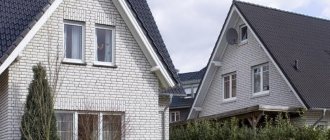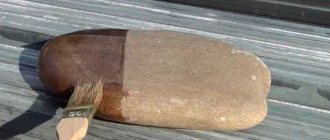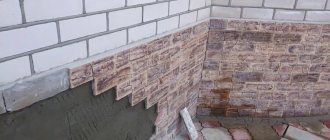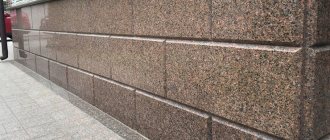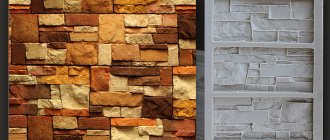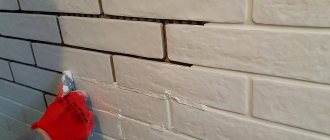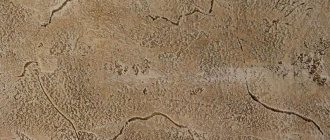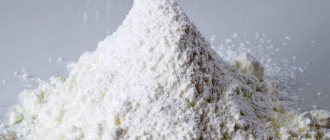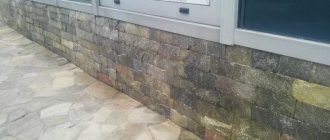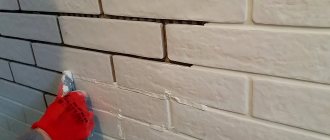The most popular building material today is rubble, which is made from parts of natural rocks. It can be artificial and natural. A rubble stone foundation is a strong foundation, the main component of which is rubble. The finished structure consists of 9 out of 10 parts.
These stones come in various shapes, sizes and weights, but the most commonly used stones on construction sites are tile rubble, with smooth and even sides. It is much easier to install it in any of the structures.
A rubble foundation is built similarly to brick walls - the component parts are stacked on top of each other and reinforced with concrete.
Disadvantages and advantages
The decision to lay a rubble foundation for a house should be made only after considering all the characteristics of this material, as well as weighing all the pros and cons. This is motivated by the fact that building such a foundation is not so easy. Firstly, this will take some time, secondly, it is necessary to take very careful measurements, and thirdly, the selection and distribution of stones over the foundation area is quite a troublesome task.
Rubble stone base
Rubble stone foundations are usually widely used when it is necessary to build a high load-bearing structure. And this is no coincidence; a foundation of this kind has a number of positive characteristics:
- environmentally friendly material;
- strength, reliability, and a guarantee of durability;
- natural water resistance;
- attractive appearance that does not require additional cladding.
But at the same time, there are also disadvantages to it. The most pronounced are:
- quite high price of natural material;
- difficulties arising during the construction of rubble structures;
- high time costs;
- difficult calculations that are made before construction begins.
A positive feature of a rubble foundation is the ability to combine different materials. For example, to make the structure a little cheaper, you can use rubble for the base located in the ground, and a brick on top. It should be remembered that the laying technology for these materials is different and must be adhered to.
Comments
Comments
Building a house is always a responsible process that needs to be approached only thoughtfully . Such a structure is being built for many years, and therefore any small details need to be considered. First of all, you need to choose the right material.
One of the interesting solutions will be rubble stone , which is rarely found for building houses, but often even foundations are made from it. But before that, it is better to consider the basic information on this issue.
Rules for laying rubble
Bite is mined through a special kind of explosion. To work with the foundation, you should select those elements that have two flat sides. The laying of a rubble stone foundation is carried out using a cement mortar using the “under the blade” principle. The thickness of the seam between each stone should be at least one and a half centimeters. It is not recommended to do more, since the rubble will settle and the structure itself will collapse.
Laying rubble stone
Before laying, the stones must be cleaned of various types of contaminants and slightly wetted. Seams with minimal dimensions, as well as the strength of the ligation of foundation parts, will facilitate the use of fragments of different sizes.
All work on laying the rubble foundation is done by hand. The largest stones are usually located at the bottom and in the corners. Due to them, the stability of the structure is achieved. This can sometimes be very difficult, since sometimes you need to turn the bottle over more than once before finding the most optimal option for its location.
To increase the bearing capacity of this type of foundation, a cement mixture solution is poured under the first row of stone. The area where the rubble will be missing is covered with small stones. Later they can be used as wedges.
All subsequent rows of masonry are made using a thicker mortar. Here they already use stones no more than 30 centimeters thick. All elements of the rubble foundation are laid in such a way that they are located close to each other with maximum density and the consumption of concrete is minimal. The top row of masonry should overlap the vertical seams of the bottom row.
The rubble base can be expanded by creating ledges consisting of at least two rows. The connecting parts of the future structure must be correctly “tied” with the upper masonry. And remember that in some places excessive load is unacceptable, since this may be followed by a shift of the stones and complete destruction of the laid layers.
Rubble masonry technology
After sorting and cleaning the rubble stone, you can begin stone work:
- Immediately before starting masonry, the rubble must be thoroughly soaked in water, since when it comes into contact with the mortar, it can remove water from it and thereby weaken the grade of the mortar.
- The first row of stones must be laid directly on the fresh concrete of the foundation (or plinth) of the building approximately four hours after the concrete has been laid. This will result in achieving high-quality adhesion between the foundation structure and the wall structure.
- To ensure an even plane of the wall, you need to pull the string from corner to corner of the building. If the dimensions of the building are large enough, then the entire length of the wall must be divided into sections of 5 - 6 meters.
- After the concrete has set, you can lay the wall using the traditional “classical” method.
- After a row or two has been laid out, after the initial setting of the mortar on which the stones are laid, it is necessary to undo the joints, which will give the wall a more neat and artistic look. When making joints, you must remember that there should be no holes or depressions between the stones in which water can accumulate or snow can accumulate. This can lead to the destruction of the wall and the formation of cracks.
Cladding of rubble foundation
If your house or other premises has a basement, then the foundation is made of rubble, at its location it must be covered with facing bricks. The lining work is carried out at the same time as the construction of the foundation. Every 4 or 6 rows are tied together with pokes.
As a result, you will receive a facing surface, the rows of which will completely coincide with the horizontal seam of the load-bearing structure. The brick base must have a thickness of more than 75 centimeters. And the rubble is laid in rows about 25 centimeters high. It is also necessary to fill with mortar all the voids that formed during the installation process.
Working on a rubble strip base
To make a strip foundation from rubble stone, you need to select a suitable site. Often this type of foundation for a building is used in places with complex soils that are prone to swelling. Before starting the main work, you need to explore the construction site and study the hydrogeological features of the area. You need to pay attention first of all to the level of groundwater, soil moisture, as well as the depth to which the ground freezes. And only then can you dig a trench.
You must first mark the area using a regular tape measure or wooden pegs and twine. You can dig a ditch yourself using a shovel or use an excavator to do the work.
The size of the stone blocks directly determines what the foundation will be like. The walls of the trench should be several centimeters wider than the rubble, since experts do not recommend laying stone end to end. And the depth of the ditch should be at least a meter.
What it is?
Rubble stone is pieces of rock characterized by non-standard shapes . Usually, fragments of sedimentary type raw materials are mined, the density of which is at least 1800 kg/1 m3. In most cases, limestone, sandstone, shell rock or diorite are used for mining. Rubble is also used to make crushed stone.
On sale you can find rectangular, rounded or sloping stones.
Characteristics of rubble stone.
- High strength. Brands M1200-M1400 are considered the most durable.
- Resistant to negative temperatures. For regions with harsh winters, use the F3000, F4000 brand.
- The compaction coefficient of the rubble depends on the dimensions of the boulder and is located at a medium or high level.
- The specific gravity varies depending on the selected variety. As a rule, a cubic meter of raw materials will weigh 2-3 tons.
- Volumetric weight no more than 50 kg.
- Bulk density is characterized by 1.3-1.9 tons per cubic meter.
- The size of the fractions is 25-50 cm.
If rubble stone is purchased for construction, you should choose a grade without cracks. You also need to pay attention to the “purity” indicator: the amount of clay or marl impurities should not exceed 2%. Purity can be determined by hitting a boulder with a sledgehammer: the higher the sonority and evenness of the sound of the blow, the more homogeneous the structure.
Recommendations from professionals
With a professional approach to work, you can reduce the time required to pour the foundation by several times. There are instructions for this:
Work with rubble on a marked area
- The site is marked.
- Trenches are dug and formwork is installed.
- A little sand is poured into the finished trench and stones are placed there, pressing them into the created “cushion”.
- All gaps resulting from laying are filled with crushed stone and compacted.
- Prepare a concrete mixture (1:3) and pour it into the first row to make it more durable.
- Another row is laid out using the same principle. At the same time, do not forget to “bandage” the seams, as when laying brick material.
- The rows that will protrude above the ground are reinforced with wire or relief reinforcement.
By following these fairly simple recommendations, you can lay out the rubble base much faster. The result is a reliable and durable structure that can withstand the heaviest buildings and is designed for long-term use.
Some tricks in constructing a rubble base
To achieve a fairly good result, you need to know something about how to simplify your work and at the same time increase its efficiency:
- the solution that will be used for pouring must be stirred periodically with a vibrator until the end of work;
- if something interferes with your work and you are forced to suspend it for more than one day, you need to create a special coating that will protect the structure from drying out. When resuming work, do not forget to clean and slightly wet the entire structure with water. Without doing this, you can break the adhesion with the other layer;
Laying a plinth made of rubble stone
In order to build a strip foundation from rubble stone, you need to prepare a cement mortar. It is almost the same as for laying brick materials. Powder grade M 400 or M 500 is used for preparation. To prevent the concrete from cracking in the end, the sand should not contain clay particles. It also needs to be cleaned of various debris and all kinds of impurities.
Initially, you need to mix cement and sand, and then add water. The consistency of the solution should resemble sour cream.
When laying a strip base made of rubble, you can use 3 methods: pouring, “under the blade” and “under the bracket”.
The first is chosen when constructing small buildings no higher than 10 meters. The stone used is different and is not selected. On top of the laid blocks, pour crushed stone (a layer of 5-10 centimeters) and compact it well.
Main sections of the online magazine “Stroy Dom”
The following sections are presented to the attention of beginners and professional builders:
- Bathhouse. This section provides information about the best materials for the construction and arrangement of a bathhouse. Such common questions as providing lighting, sewerage and water supply to a bathhouse are described in detail in this section of the site. After reading the materials presented in this section, you will also know which stones, floors, furniture and roofing are best suited for a bathhouse. Thanks to the advice of our specialists, you will be able to independently install windows and doors in this room, as well as conduct electrical wiring.
- Water supply. From this section you will learn about which pipes are best suited for water supply, how to equip wells of various types, what malfunctions may occur in the water supply and pipeline systems and how to eliminate them. After studying the materials, you will be able to build a well yourself, supply water to the house, and install a shower.
- Country house. Builder authors give advice and answer common questions regarding the arrangement of a country house.
- Sewerage. This section will come to the aid of those who do not know how to properly drain a summer shower, install and operate a dry closet, which sewerage system to choose for their dacha, or how to install plumbing equipment.
- Roof. Don’t know what materials are best to choose for the roof of a country house and other buildings on a personal plot? The advice of experienced specialists will help you with this. Also from this section of the site you can get useful information on how to carry out installation work of roofing coverings and properly care for them.
- Heating. How to install a wood-burning stove, which pipes to choose for a heating boiler, which heating devices to choose in order to ensure warmth and comfort in the country house during the cold season, and many other questions you can solve by studying the material in this section.
- Basement and cellar. This section provides information on the correct arrangement of the basement and cellar in the country.
- Walls. After getting acquainted with this section of our website, you will be able to independently choose the material for the construction of walls, carry out their insulation and insulation, and carry out finishing work.
- Electrics. Not everyone knows which sockets are best to choose for their dacha, how to install electrical wiring in the house, install video surveillance, select chandeliers and other lighting fixtures. This section describes in detail these and many other points related to the electrical system of a private house and apartment.
Selection, installation, operating rules for windows and doors, the best floor coverings for a house and apartment, reliable security systems, features of finishing work, types of foundations and its construction - you can learn information and useful tips on these construction topics from the pages of the online magazine " Build a House."
There are several ways to build foundations for private houses and cottages using various building materials. Since ancient times, rubble has been used to form foundations. Its popularity has continued to this day.
Thanks to its unique properties, natural stone creates a stable surface with high load-bearing capacity. Not so long ago they began to produce an artificial analogue, which does not compromise on the technical characteristics of the natural material.
The rubble consists of large and medium-sized fragments of sandstone and limestone rocks. It is mined in different ways, but only one has the most negative impact on the structure and properties of the stone - blasting. It is not recommended to use such material for the foundation.
Pros and cons of stone houses
Everyone imagines what a stone house looks like, since the Internet is full of photos of houses made of stone. And it is not at all logical to imagine that the structure of a stone house will be using unprocessed materials, because humanity has learned not only to process natural stones, but also to create indescribable beauty from them.
In stone house projects, most often the priority is either shell rock or granite. Such stones are best suited for laying the walls of houses.
Rubble stone plinth
Rubble stone is very convenient for covering the base. This plinth looks very beautiful, especially when it is lined with stones of various sizes.
Designers advise choosing a stone in a contrasting color with the wall of the house or a similar shade.
An example of cladding the base of a wooden house with rubble stone
Application of decorative stone
In modern life, you can often see a house made of decorative stone. The main difference between decorative stone and natural stone is that it is not mined naturally, but is processed and produced industrially, that is, it is an artificial stone.
Currently, there are many varieties of decorative stones - these are the same concrete, ceramics, gypsum, acrylic, polyester materials. Liquid stone has special properties, which hardens only after installation.
For exterior work, more durable materials that are resistant to frost are used, and for the interior of the house, thinner materials can be used. In terms of their properties, these materials are in no way inferior to natural stone, only you need to be careful with acrylic resins; they can only be used at low temperatures.
Decorative stone can be used for interior decoration in the living room, kitchen, and bedroom. It will look ergonomic and aesthetically pleasing.
Technical characteristics and classification
- The main characteristic of rubble stone is its compressive resistance. It is this parameter that determines the grade of the material, which ranges from 100 to 1200. In other words, rubble stone can withstand compressive loads from 100 kg/cm2 to 1200 kg/cm2.
- The frost resistance of rubble must be at least 15 cycles. That is, the material is subjected to freezing and thawing at least fifteen times and this does not affect its load-bearing capacity. Brands of rubble stone according to this indicator can range from F15 to F300.
- Flakiness is a very important characteristic of rubble. The concept of flakiness allows us to determine the ratio of needle-shaped and flat grains in a stone. According to this indicator, bute is divided into five groups from group V (35-50%) to group I (less than 10%).
- The radioactivity of the material is divided into two classes:
- Class I (up to 370 Bq/kg) for the use of rubble in residential areas and populated areas;
- Class II (over 370 Bq/kg) for the use of stone in industrial construction.
There is another absolutely individual indicator, which is characterized by the tonality of the sound made by the stone after being hit with a hammer. The louder and smoother the sound, the fewer various impurities in the stone, the more uniform its structure.
Possible combinations
You can also find combined houses made of stone.
Decorative stone combined with natural finishes and clean stonework can create beauty both outside and inside a home. The material can be polished in various shades and types (glossy, matte, satin).
The option of combining natural stone with artificial will cost you much less than finishing with natural stone alone.
A message from the Tudor era
The design of the façade of this modern cottage harkens back to the Tudor era. This is evidenced by the outline of the roof, the combination of smooth plaster and half-timbered elements in the decoration, and restrained wooden decor. The portico in the entrance area is made of wild stone.
All types of natural stone mentioned in the selection of projects are presented in our assortment. cooperates with the best Russian quarries. A variety of stone grades allows you to choose cladding and paving materials for any project.
Laying stone
As in the construction of brick houses, stone is also laid piece by piece. The stones are connected to each other with a special mortar, which must be selected according to its intended purpose and depending on the operating conditions. Also, we must not forget about the strength of the cement mortar.
For construction in wet areas, a high-strength mortar should be selected, but for dry areas, lower strength is suitable, but high plasticity of the mortar is required. It is allowed to add other mixtures to the solution (for example, clay, to increase mobility).
Construction work must take place at a temperature not lower than 0, because too low a temperature during work can affect the quality of the building.
Exterior finishing of the house with stone
Finishing a house with stone is a good solution. This makes it possible to reduce the cost of building materials. The modern market offers a lot of solutions for exterior design, including natural and artificial materials.
Natural stones include granite, limestone, sandstone, and marble. The list of popular artificial options includes concrete, porcelain tiles, polymer or clinker tiles.
The price of stone for exterior decoration of a house directly depends on the type of material used. Considering the high cost of natural processed stone, combined finishing schemes are often used, when only part of the structure is faced with stone.
This option has a very aesthetic appearance.
